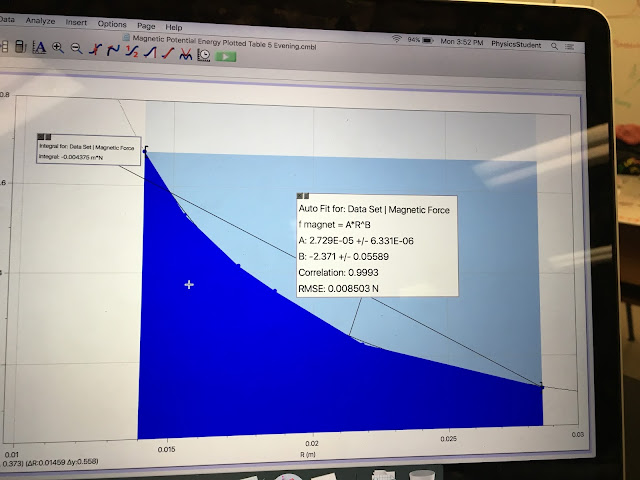Purpose: Determine the moment of inertia of a uniform right triangle rotating about its center of mass in two different orientations.
Theory: The inertia of an unknown rotating object can be found by first rotating an object of known inertia and finding its angular acceleration by a constant force, then rotating the same object with the new unknown object attached and finding its angular acceleration and moment of inertia. Since inertia of an object can be thought of as a sum of the inertia of its components, by subtracting the two moments of inertia, the moment of inertia of just the unknown object may be found. A comparison may be made to the mathematical determination of the moment of inertia to verify the results.
Apparatus:
- Rotating disc/pulley setup
- Steel right triangle
- Hanging mass
- Logger Pro
- Digital scale
- Vernier caliper
Procedure:
Use a large diameter pulley wheel on the rotating discs and attach the triangle holding clamp without the triangle. Weigh the hanging mass to be used and rotate only the top steel disc to find its angular acceleration. Calculate a value of inertia for the top disc with attached clamp. Then, affix the triangle so that its longer non-hypotenuse side is oriented vertically. Conduct the same experiment to determine the angular acceleration of the triangle-disc system and calculate its inertia. Then, orient the triangle so that the previously vertical side is now the base of the triangle. Conduct the same experiment again and calculate a value of inertia.
Data and Graphs:
Photo of experimental apparatus:
Graphical analysis of disc-only system
Graphical analysis of vertically oriented triangle:
Graphical analysis of horizontally oriented triangle:
Table of collected and calculated data (Note: angular accelerations are all multiplied by x1.8 to account for calibration error):
| Mtriangle | 0,457 | kg | |||||
| Mhanging | 0,025 | kg | |||||
| Dpulley | 0,0499 | m | |||||
| Long side | 0,1493 | m | |||||
| Short side | 0,0986 | m | |||||
| System | α up (rad/s^2) | α down | α avg | Isystem (kgm^2) | Itriangle (kgm^2) | Calculated I | %Error |
| Disc | 6,489 | 5,897 | 6,193 | 0,0009881 | / | / | |
| Short base | 5,216 | 4,691 | 4,954 | 0,001235 | 0,0002472 | 0,0002468 | 0,14827862 |
| Long base | 4,109 | 3,731 | 3,920 | 0,001561 | 0,0005727 | 0,0005659 | 1,203539002 |
Data Analysis:
To account for friction, an average angular acceleration was taken. Inertia of the system was calculating using t = I * r where r was the radius of the pulley and the torque was supplied by only the hanging mass. The theoretical moment of inertia was calculated using the equation I = 1/18 MB^2
and compared to experimental values.
Conclusion:
The moment of inertia of the experimental regular right triangle with its short side as its base is approximately 0.002472kgm^2, giving a percentage error of 0.148% compared to the theoretical value. When the triangle has its long side as the base, the moment of inertia was found to be approximately 0.0005727kgm^2, giving a percentage error of 1.20% compared to the theoretical value. These results, despite the error in calibration of the apparatus, are likely valid as much of the small error is due to the effects of friction which effectively increases the moment of inertia, producing the results seen in this experiment where experimental values were greater than theoretical values. The relatively few number of calculations also helped to reduce the error due to uncertainties in measurements.

























